Vermicomposting
Vermicomposting
Why vermicomposting?
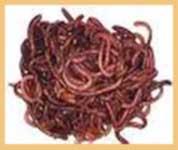
- The chief objective is to compost organic wastes not for the disposal of solid organic wastes but also to produce superior quality manure to feed our “nutrient/organic matter hungry” soils.
- Large volume of organic matter generated from agricultural activities, dairy farms and animal shelters usually dumped in corners emanating foul smell, can be utilized by properly composting it into a value-added end product
Vermicomposting using local varieties of earthworms
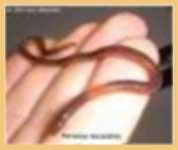
- Out of two thousand five hundred species of earthworms identified in the world, more than five hundred species of earthworms have been identified in India.
- Earthworm diversity varies with soils and choosing a native species for vermicomposting is necessary and there is no need to import them.
- Local species used in India are Perionyx excavatus and Lampito mauritii.
- These earthworms can be cultured or used in composting applying simple procedures either in pits, crates, tanks, concrete rings or any containers.
How to collect native earthworms?
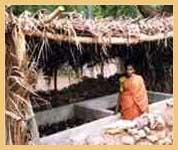
- Identify worm-inhabited soils marked by visible earthworm castings on the soil surface.
- Dissolve 500 g jaggery (native sugar) and 500 g fresh cattle dung in 2 litres of water and sprinkle on an area 1m × 1m surface soil.
- Cover with straw lumps and cover with an old gunny bag.
- Keep sprinkling water for about 20 to 30 days.
- Native worms will aggregate in the spot and can be collected and used.
Preparation of Compost pit
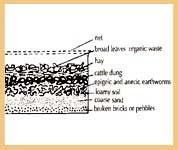
- Compost pit of any convenient dimension can be constructed in the backyard or garden or in a field.
- It may be single pit, two pits or tank of any sizes (manageable size is 2 m x 1m x 0.75 m) with brick and mortar with proper water outlets.
- To combat the ant menace, have a water column in the centre of the parapet wall of the vermipits
- The ‘four chamber’ pit will facilitate easy and continuous movement of earthworms from one chamber with fully composted matter to the one with the pre-processed waste in the chambers
Preparation of Vermibed
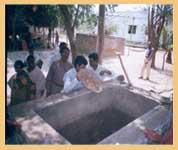
- Vermibed is the layer of moist loamy soil placed at the bottom, about 15 to 20 cm thick above a thin layer (5 cm) of broken bricks and coarse sand.
- Earthworms are introduced into the loamy soil, which the worms will inhabit as their home.
- 150 earthworms may be introduced into a compost pit of about 2m x 1m x 0.75m, with a vermibed of about 15 to 20 cm thickness.
- Handful‑lumps of fresh cattle dung are then placed at random over the vermibed.
- The compost pit is then layered to about 5 cm with dry leaves or preferably chopped hay/straw or agricultural waste biomass.
- For the next 30 days the pit is kept moist by watering it whenever necessary.
- The bed should neither be dry or soggy.
- The pit may then be covered with coconut or Palmyra leaves or an old jute (gunny) bag to discourage birds.
- Plastic sheets on the bed are to be avoided as they trap heat.
- After the first 30 days, wet organic waste of animal and/or plant origin from the kitchen or hotel or hostel or farm that has been pre-digested is spread over it to a thickness of about 5 cm. Repeat this twice a week.
- All these organic wastes can be turned over or mixed periodically with a spade.
- Regular watering should be done to keep the pits moist.
- If the weather is very dry, it should be checked periodically.
When will the compost be ready?
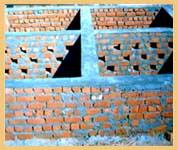
- The compost will be ready in 60 to 90 days and the material becomes moderately loose, crumbly with dark brown colour. It will be black, granular, lightweight and humus-rich.
- Presence of earthworm castings (vermicompost) on the top of the bed is also an indicator and vermicompost can be harvested.
- Stop watering two to three days before emptying the beds to facilitate separating the worms from the compost (80 per cent of the worms will move to the bottom of the bed).
- The harvested material should be placed in a heap in the sun so that most of the worms move down to the cool base of the heap.
- In the two or four pit system, watering should be stopped in the first chamber so that worms will automatically move to another chamber where the required environment for the worms are maintained in a cyclic manner and harvesting can be done continuously in cycles.
Separation of earth worms:
- The worms can be separated by using sieves/meshes.
- The earthworms and the thicker material, which remains on top of the sieve, are recomposted.
- The smell of the compost is earth-like.
- Any bad odour if formed is a sign that fermentation has not reached its final goal and that the bacterial processes are still going on.
- A musty smell indicates the presence of mold or overheating which leads to loss of nitrogen.
- If this happens, aerate the heap better or start again, adding more fibrous material and keeping the heap drier.
- The compost is then sieved before being packed.
Advantages of Vermicomposting
- Organic wastes can be broken down and fragmented rapidly by earthworms, resulting in a stable nontoxic material with good structure, which has a potentially high economic value and also act as soil conditioner for plant growth.
- Vermicompost supplies a suitable mineral balance, improves nutrient availability and could act as complex-fertilizer granules.
- Vermicomposting involves great reduction in populations of pathogenic microorganisms, thus not differing from composting from this point of view.
- Vermicomposting also leads to decrease the environmental problems arising from their disposal, without needing in many cases to complete the process.
- It should be realized that vermicomposting can be a useful cottage industry for the underprivileged and the economically weak as it can provide them with a supplementary income.
- If every village can formulate a cooperative society of unemployed youth/women group, it could be a wise venture for them to produce vermicompost and sell it back to the village at a recommended price. The youth will not only earn money, but also aid society by providing excellent quality organic manure for sustainable agro-practices.
Source: Shri AMM Murugappa Chettiyar Research Centre (MCRC), Chennai
Related resources
Last Modified : 2/19/2020
© C–DAC.All content appearing on the vikaspedia portal is through collaborative effort of vikaspedia and its partners.We encourage you to use and share the content in a respectful and fair manner. Please leave all source links intact and adhere to applicable copyright and intellectual property guidelines and laws.
RELATED ITEMS
Zero tillage Zero worries
This topic provides information about Zero tillage...
Acute Encephalitis Syndrome
This topic provides information about Causes, targ...
*99# Service- Innovative payment service
This topic provides about *99# Service- Innovative...
Accessible Elections
This topic provides information related to steps t...
RELATED LANGUAGES
